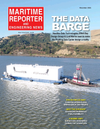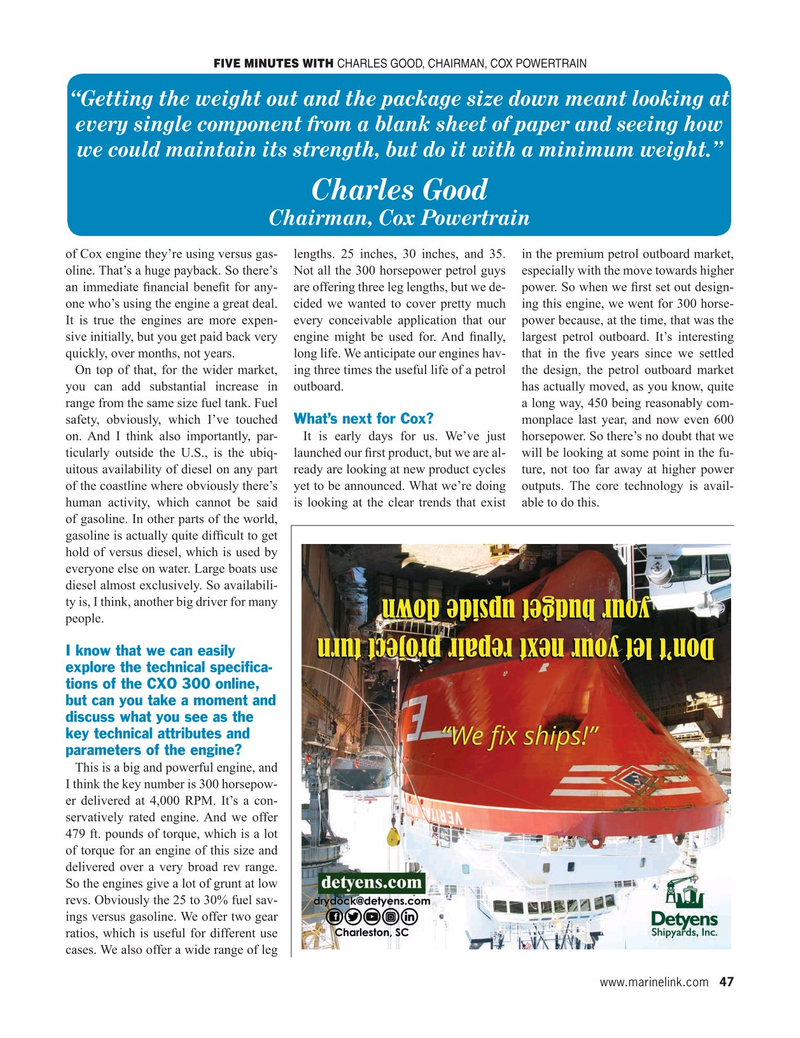
Page 47: of Maritime Reporter Magazine (November 2021)
The Workboat Edition
Read this page in Pdf, Flash or Html5 edition of November 2021 Maritime Reporter Magazine
FIVE MINUTES WITH CHARLES GOOD, CHAIRMAN, COX POWERTRAIN “Getting the weight out and the package size down meant looking at every single component from a blank sheet of paper and seeing how we could maintain its strength, but do it with a minimum weight.”
Charles Good
Chairman, Cox Powertrain of Cox engine they’re using versus gas- lengths. 25 inches, 30 inches, and 35. in the premium petrol outboard market, oline. That’s a huge payback. So there’s Not all the 300 horsepower petrol guys especially with the move towards higher an immediate ? nancial bene? t for any- are offering three leg lengths, but we de- power. So when we ? rst set out design- one who’s using the engine a great deal. cided we wanted to cover pretty much ing this engine, we went for 300 horse-
It is true the engines are more expen- every conceivable application that our power because, at the time, that was the sive initially, but you get paid back very engine might be used for. And ? nally, largest petrol outboard. It’s interesting quickly, over months, not years. long life. We anticipate our engines hav- that in the ? ve years since we settled
On top of that, for the wider market, ing three times the useful life of a petrol the design, the petrol outboard market you can add substantial increase in outboard. has actually moved, as you know, quite range from the same size fuel tank. Fuel a long way, 450 being reasonably com-
What’s next for Cox?
safety, obviously, which I’ve touched monplace last year, and now even 600 on. And I think also importantly, par- It is early days for us. We’ve just horsepower. So there’s no doubt that we ticularly outside the U.S., is the ubiq- launched our ? rst product, but we are al- will be looking at some point in the fu- uitous availability of diesel on any part ready are looking at new product cycles ture, not too far away at higher power of the coastline where obviously there’s yet to be announced. What we’re doing outputs. The core technology is avail- human activity, which cannot be said is looking at the clear trends that exist able to do this.
of gasoline. In other parts of the world, gasoline is actually quite dif? cult to get hold of versus diesel, which is used by everyone else on water. Large boats use diesel almost exclusively. So availabili- ty is, I think, another big driver for many people.
I know that we can easily explore the technical speci? ca- tions of the CXO 300 online, but can you take a moment and discuss what you see as the key technical attributes and parameters of the engine?
This is a big and powerful engine, and
I think the key number is 300 horsepow- er delivered at 4,000 RPM. It’s a con- servatively rated engine. And we offer 479 ft. pounds of torque, which is a lot of torque for an engine of this size and delivered over a very broad rev range.
So the engines give a lot of grunt at low revs. Obviously the 25 to 30% fuel sav- ings versus gasoline. We offer two gear ratios, which is useful for different use cases. We also offer a wide range of leg www.marinelink.com 47
MR #11 (34-49).indd 47 11/4/2021 11:03:22 AM

 46
46

 48
48
